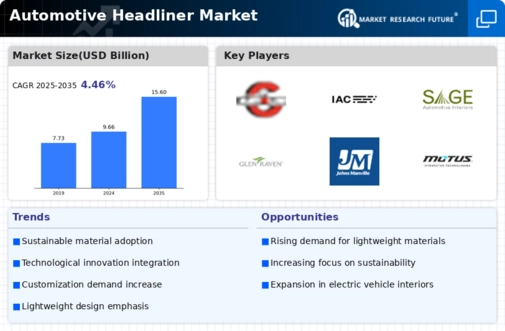Top Industry Leaders in the Automotive Headliner Market
*Disclaimer: List of key companies in no particular order
Latest Company Updates:
Competitive Landscape of the Automotive Headliner Market: A Strategic Analysis
However, navigating this dynamic landscape requires a clear understanding of the competitive strategies, key factors influencing market share, and emerging trends shaping the future.
Key Players & Their Strategies:
Global Giants: Companies like Grupo Antolin, Motus Integrated Technologies, and Toyota Boshoku Corporation dominate the market with diversified product portfolios, geographical reach, and strong relationships with major automakers. Their strategies revolve around continuous innovation, technological advancements in lightweight materials and acoustic insulation, and acquisitions to strengthen their hold on premium and luxury segments.
Regional Players: Companies like Kasai North America, International Automotive Components Group SA, and Howa Co., Ltd. cater to specific regional demands and niches. They excel in cost-effective manufacturing, personalized service, and quick adaptation to local regulations, making them strong contenders in budget-conscious segments.
New Entrants: Emerging players like UGN, Inc. and SA Automotive are bringing fresh perspectives through disruptive technologies like fiber optic headliners and integrated lighting systems. These companies leverage partnerships with technology startups and focus on offering unique features to cater to the evolving tastes of tech-savvy consumers.
Factors Influencing Market Share:
Product Portfolio & Innovation: Offering a diverse range of materials, textures, and functionalities remains crucial for differentiation. Players investing in sustainable, lightweight fabrics, noise-canceling technologies, and integrated ambient lighting will gain an edge.
Cost Competitiveness & Efficiency: Balancing quality with affordability is vital, especially in price-sensitive segments. Optimizing production processes, utilizing cost-effective materials, and establishing regional manufacturing hubs will be key factors.
Customer Relationships & OEM Partnerships: Strong collaboration with automakers, adaptability to specific vehicle requirements, and offering customized solutions will secure long-term contracts and boost market share.
Geographical Expansion & Emerging Markets: Capitalizing on the rapid growth of the automotive industry in regions like Asia-Pacific and Latin America presents significant opportunities for player expansion and market penetration.
New & Emerging Trends:
Lightweight Materials & Sustainability: The adoption of recycled and lightweight materials like bio-based fabrics and thermoplastics aligns with both environmental regulations and fuel efficiency demands, driving product innovation.
Integration of Technology & Smart Features: Headliners are evolving into platforms for advanced driver-assistance systems, mood lighting, and integrated infotainment screens, creating new revenue streams and enhancing user experience.
Personalization & Customization: Offering custom patterns, textures, and lighting options enables consumers to personalize their vehicle interiors, creating a unique selling proposition for manufacturers.
Focus on Safety & Regulations: Stringent safety regulations regarding sound insulation, fire retardancy, and crashworthiness are shaping material selection and design processes, influencing market dynamics.
Overall Competitive Scenario:
The automotive headliner market is characterized by moderate competition with a mix of established players, regional specialists, and innovative newcomers. While global giants hold a significant market share, regional players and niche specialists pose strong challenges through agility, cost-effectiveness, and catering to specific needs. Success in this dynamic market demands continuous innovation, strategic partnerships, adaptation to emerging trends, and a focus on both sustainability and customer-centric solutions. Players who proactively adapt their strategies and offerings to these evolving forces will be best positioned to capture the immense growth potential of the automotive headliner market in the years to come.
Grupo Antolin (Spain): Partnered with Faurecia (France) to develop lightweight headliners using recycled materials. Launched a new headliner with integrated lighting and air vents. (Source: Grupo Antolin press release, September 2023)
Toyota Boshoku Corporation (Japan): Developed a headliner made from plant-based fibers for the Lexus RZ electric SUV. Introduced a noise-absorbing headliner for improved cabin silence. (Source: Toyota Boshoku press release, June 2023)
Oracle Lighting: Offers custom LED lighting kits for headliners, allowing for personalization and improved cabin illumination. (Source: Oracle Lighting website)
Lear Corporation (US): Partnered with Johns Manville (US) to develop headliners with improved thermal and acoustic performance. Introduced a lightweight headliner with integrated sunshades. (Source: Lear Corporation press release, July 2023)
UGN Inc. (Japan): Developed a headliner with integrated air purifier for cleaner cabin air. Introduced a headliner with adjustable ambient lighting for improved ambiance. (Source: UGN Inc. website)
Top listed global companies in the industry are:
Grupo Antolin (Spain)
Toyota Boshoku Corporation (Japan)
InterActiveCorp (US)-
Oracle Lighting
IAC Group
Lear Corporation (USUS.)
UGN Inc. (Japan)
Sage Automotive Interiors (US)
Glen Raven Inc. (US.)
Cindus Corp (US)
Johns Manville (U.S.)
Motus Integrated Technologies (US)









